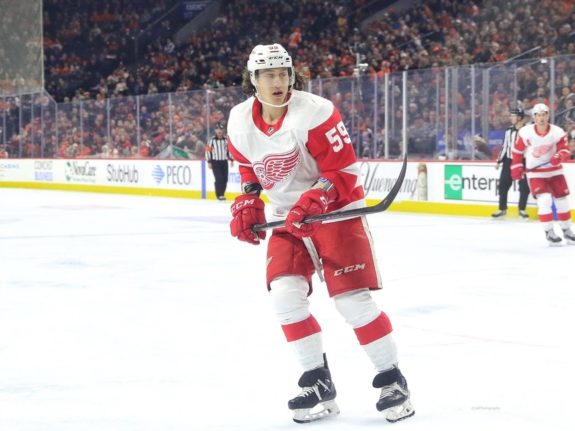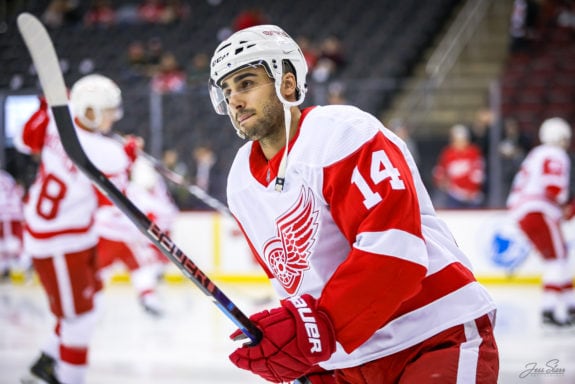As a whole, the Detroit Red Wings improved this season. But what about the individual players?
Prior to the 2020-21 campaign, I outlined benchmarks for Detroit’s young core – goals that exemplified developmental progress. Now that the season is over, let’s revisit those benchmarks, see how the players fared, and dish out pass/fail grades accordingly.
Anthony Mantha
Goal: Stay healthy and score 25 goals.
Metrics: Games played and goals.
Analysis: Apart from being a healthy scratch for a game, Mantha was consistently healthy this season. Unfortunately, his scoring did not have the same luck. Before Mantha was traded to the Washington Capitals, he scored 11 goals for the Red Wings – likely not enough to reach 25 if he stayed in Detroit.
Grade: Incomplete
Tyler Bertuzzi
Goal: Become a better play driver.
Metrics: 5v5 Corsi-for per 60 relative (CF/60 Rel).

Analysis: It’s not appropriate to grade Bertuzzi this season, given he only suited up for nine games. However, he did produce solid results in a small sample size. Bertuzzi’s 10.79 CF/60 Rel led the Red Wings this season. This was an improvement over his 9.24 CF/60 Rel from the 2019-20 season.
Anecdotally, Bertuzzi was more of a catalyst in the offensive zone than a traditional driver through the neutral zone. His offense, depth, and tenacity were missed after he went down with a back injury.
Grade: Incomplete
Evgeny Svechnikov
Goal: Play 20-plus games and have a Corsi-for percentage above 50 percent.
Metrics: Games played and 5v5 Corsi-for percentage (CF%).
Analysis: Svechnikov skated in 21 games, recording three goals and eight points for the Red Wings. He started off strong, but did not factor in much down the stretch. Not having a solidified spot in the lineup likely contributed to his sluggish finish.
Considering the fact that only Bertuzzi topped 50 percent for CF%, it should come as no surprise that Svechnikov didn’t achieve the second part of his goal. His 46.92% CF% ranked ninth among Red Wings forwards. Diving deeper, his -10.02 CA/60 Rel ranked second on the team, indicating solid defensive work by the Russian forward. Because of this, he gets a pass.
Grade: Pass
Michael Rasmussen
Goal: Play 25-plus games and be dependable at even strength.
Metrics: Games played, plus 5v5 Corsi-for/60 (CF/60) and 5v5 Corsi-against/60 (CA/60).
Analysis: Rasmussen easily met his games-played goal, skating in 40 of Detroit’s 56 games. After the trade deadline, he frequently lined up in the top six.
As far as being dependable at even strength goes, there are two viewpoints to consider. From a qualitative perspective, Rasmussen took tremendous strides this year.
But when you look at the underlying numbers, it wasn’t great. Rasmussen’s CF/60 (38.61) and CA/60 (59.89) actually rank among the NHL’s worst. Then again, none of Detroit’s forwards had outstanding numbers this year.
If anything, this shows that while Rasmussen looked the part of an NHLer, there’s still room to grow. Based on Blashill’s comments and my own viewings, I’m inclined to reward the hulking center for his development this season.
Grade: Pass
Robby Fabbri
Goal: Establish himself as an effective middle-six center.
Metrics: 5v5 Corsi-for/60 (CF/60), 5v5 Corsi-against/60 (CA/60), 5v5 expected goals-for per 60 (xGF/60).

Analysis: I’m tempted to put “Incomplete” here since Fabbri did not stick at center and eventually shifted back to the wing. Instead, I’m going to revise the goal and evaluate Fabbri on his work as a middle-six forward.
Overall, Fabbri’s underlying numbers were not great. His CF/60 (46.53), CA/60 (58.52), and xGF/60 (1.9) all ranked outside the top 200 among NHL forwards with at least 200 minutes played at five-on-five. However, his GF/60 (3.0) ranked 70th in the NHL, so it’s not all bad. But if Fabbri’s going to be part of Detroit’s top six, he needs to produce more.
Grade: Fail
Filip Hronek
Goal: Score double-digit goals and finish with an expected goals-for percentage above 50 percent.
Metrics: Goals and 5v5 expected goals-for percentage (xGF%).
Analysis: First and foremost, Hronek only scored two goals this season – both of which being empty-netters. So the first part of his goal clearly was not met.
Hronek did not fare well when it came to xGF%, either. The original goal was rooted in a desire to see the 23-year-old defenseman take a step forward offensively. His 26 points did lead the team, but he did not produce enough offense in general. Hronek’s defensive play didn’t make up for his offensive woes – as evidenced by his 45.02% xGF%.
Overall, Hronek was fine this season. He grew in some regards and was tasked with quite a bit as Detroit’s go-to defenseman. He just didn’t reach the goals I set at the beginning of the season.
Grade: Fail
Filip Zadina
Goal: Score 15 goals and remain a fixture in Detroit’s top six.
Metrics: Goals and average time on ice (ATOI).
Analysis: Like most other Red Wings, Zadina did not score as often as he would have liked to this season. He tallied six goals, which ranked ninth among Detroit’s forwards. Valtteri Filppula and Luke Glendening also scored six goals this season – probably not the company Zadina wants to be in.
However, he did maintain a spot in Detroit’s top six throughout the year. Zadina’s 16:48 ATOI ranked fifth among forwards. After the trade deadline, his ATOI rose to 17:43, trailing only Dylan Larkin in the category.
Grade: Fail
Dylan Larkin
Goal: Establish himself as a true No. 1 NHL center.
Metrics: 5v5 Corsi-for/60 (CF/60), 5v5 Corsi-against/60 (CA/60), 5v5 scoring chances for per 60 (SCF/60), and faceoff percentage (FO%).
Analysis: Among Red Wings forwards, Larkin’s underlying numbers were favorable. But compared to the rest of the league, they were not.
| Metric | Result | Red Wings Rank | NHL Rank |
| CF/60 | 51.8 | 1st | 230th |
| CA/60 | 55.05 | 8th | 280th |
| SCF/60 | 25.26 | 1st | 192nd |
| FO% | 49.5% | 2nd | 91st |
All stats five-on-five. Minimum 200 minutes time on ice. Minimum 100 faceoffs.
Normally, I’d compare his output to other 1Cs. But, simply put, this was not Larkin’s year. No further analysis needed.
Heading into next season, consider Larkin as a prime bounce-back candidate. A normal summer to train, plus training camp’s worth of practices and healthy, consistent linemates will bring out his best.
Grade: Fail
Final Word
As a whole, the Red Wings improved this season. But some of their key players failed to live up to expectations. Injuries, constant line shuffling, and minimal practice time hindered any attempts to build chemistry.
Related: Red Wings Improved in 2020-21 – But by How Much?
That said, the organization is trending in the right direction. Some of Detroit’s young core just need to step up next season as the rebuild progresses.
Stats courtesy of Natural Stat Trick and NHL.com.